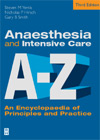Features
This 3rd edition covers both basic sciences and clinical
practice, and has been expanded to include intensive care in
greater detail
The extensive cross-referencing by an experienced author team
ensures easy access to related information
Major topics, easily forgotten formulae, and definitions are all
covered in bite-sized summaries covering all aspects of the FRCA
syllabus, providing you with a one-stop reference of the
essential terminology and formulae in one easily accessible book
Illustrated throughout with clear drawings and tables
Covers pharmacology, physiology, anatomy, physics, statistics,
medicine, surgery, general anaesthetic practice, intensive care,
equipment
What's New
Both Anaesthesia and Intensive Care entries have been greatly
expanded to reflect the latest advances
New entries include Creutzfeldt-Jakob Disease, new monitoring
modalities, herbal medicines, MOET scoring system (monitoring
obstetric emergencies and trauma) and pharmakogenetics
Now incorporates the professional standards and guidelines from
the Association of Anaesthetists of Great Britain and Ireland
Incorporate latest guidelines in CPR
All drug doses updated and new drugs and techniques added
All illustrations professionally redrawn and a quarter of them
are brand-new
Contents
Entries arranged alphabetically, with some related subjects
grouped together to make coverage of these easier. A-Z of
Anaesthetic and Intensive Care Terminology (i.e. Abdominal
decompression + definition - Zone of risk + definition).
Typical entry:
Pain Clinic . Outpatient clinic run by consultants (usually
anaesthetists) with a special interest in the management of
chronic pain. Developed from the 1950s. Its role includes
diagnosis of the underlying condition and management directed at
reducing subjective pain experiences, reducing drug consumption,
increasing levels of normal activity and restoring quality of
life. Requires appropriate facilities for consultation, and
performance of nerve blocks and surgical procedures.
Anaesthetists, physicians, psychologists, and neurologists may
be involved. Primary referrals to the clinic are usually from
general practitioners or hospital consultants.
Swerdlow M (1992). Anaesthesia; 47:977-80
See also, Pain management


